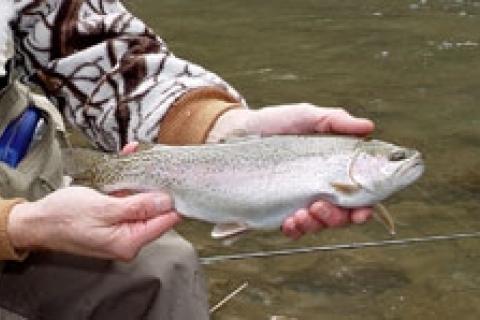
 Dense fog, the result of comparatively warm air pockets combined with remaining snow cover, enshrouded the ridge tops as we made the two hour drive to the limestone spring creek. It would be mid-morning by the time we were rigged up and fishing, but my partner Tom Ference wasn't concerned.
Dense fog, the result of comparatively warm air pockets combined with remaining snow cover, enshrouded the ridge tops as we made the two hour drive to the limestone spring creek. It would be mid-morning by the time we were rigged up and fishing, but my partner Tom Ference wasn't concerned.
"There's no reason to be on the stream at the crack of dawn," Ference, a longtime veteran of the trout streams, confidently noted. "The best time during cold winter days is usually between 10 a.m. and 4 p.m., typically the warmest part of the day."
Tom's comment proved to be prophetic. My second cast into the tailout of a moderately deep run produced a 2-pound rainbow, a fish that took a size 8 Woolly Bugger fished on a dead drift. It was the first of several trout — holdover rainbows and wild browns — we'd catch that delightfully mild early February day.
Spring creeks, which receive a significant portion of their volume from underground limestone aquifers, often provide wintertime trout fishing opportunities when nearby freestone streams are iced up.
"These streams rarely freeze due to the warmer water temperatures provided by the underwater springs," Ference explained. "The fish are more active. They remain in a feeding mode due to the more constant water temperatures and the available food sources."
In addition to being warmer, Ference said that while spring creeks are relatively clear, they generally have a touch of tint, a situation he says is ideal for presenting offerings without spooking wary fish. And since it's winter, fishing pressure is either light or non-existent.
Due to the high-quality nature of spring creeks they (or portions of) are often managed with special regulations, such as total catch and release, or certain tackle restrictions. So be sure to check the regulations that apply to any such stream you fish. That being said, wintertime spring creek trout can be taken on a variety of presentations, with both fly rod and spinning rod. Regardless of the tackle choice, Ference said slow and deep is the rule, an approach that keys in on slower, deeper stream sections.
 |
| Trout expert Tom Ference with a spring creek rainbow. |
"With the fly rod, the 'high sticking' rod technique with a minimum of casting is generally best," he noted. "If you are using a strike indicator, the yarn-style makes less of a splash on the water and reacts well to subtle takes. Dead-drifted weighted nymphs and slowly swinging sculpins and Woolly Buggers work best. Keep the fast paced strip movements to a minimum, if at all."
During our outing, Ference and I consistently scored by fishing weighted Woolly Buggers with a classic cross-current cast, where the mending of the line allowed the fly to freely drift down to into the deeper, rock-protected pockets where the fish were holding. Many of the fish took the fly at the end of the swing, which is so often the case with this technique.
Other flies recommended by Ference include bead-head Hare's Ear nymph, cress bugs, sow bugs, Blood Dot and sucker spawn eggs, and crayfish patterns. He also noted — on the streams he fishes — during unseasonably warm winter days black midges sometimes come off. Being familiar with the hatches on your local waters can prepare you for the bonus surface activity on your waters.
Spin fishing can also be very effective in the wintertime, especially if the angler incorporates some modification in his or her approach.
 |
| Good wintertime fly selections for spring creeks will include streamers like Wooly Bugger and Sculpins, as well as nymphs and egg patterns. |
"Try casting a spinner with an upstream cast, and then retrieving it back downstream just fast enough so that the blade rotates," Ference suggested. "This keeps the lure deep, and slows it down enough so that the fish feels confident it can intercept it. Another tip is to paint your favorite spinner all black."
When fishing a spinner in the more conventional cross-stream or downstream manner, he adds a split shot so the lure can be fished deeper and slower. If there's enough current, he'll even simply hold the bait still and let it hang.
"Smaller sized suspending jerkbaits can also entice fish, particularly larger fish," he added. "And smaller sized jigs rigged with twister-tail bodies are worth a try. Fish them slow as well. Providing too much lure movement will discourage a trout from reacting, feeling the prey is more likely to escape."
Where regulations allow, natural bait can be used effectively to dupe winter time trout from limestone streams. The same dead-drifting tactics mentioned earlier can be employed with dead (but still fresh) minnows, salted minnows, maggots, meal worms and crayfish. Long spinning rods, such as those used by salmon/steelhead anglers, can be beneficial in keeping in contact with the presentation to detect bites.
Trout found in limestone streams are of such value that releasing them makes sense, even if regulations don't demand it. Often they are wild fish, or ones from stockings that can hold over due to the quality environment in which they live. Regardless of the tackle uses, pinch down barbs to make releasing fish an easy task that doesn't beat up the fish.
| More Wintertime Trout Tips
|
- 4865 views

